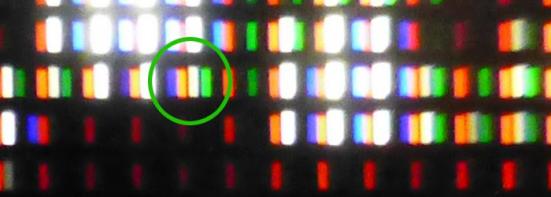I don’t think any of the photos in this thread are that zoomed in, or so in focus. It’s pretty easy to take a picture where you can’t make out the individual dots and they appear as a stripe instead.
Also, I don’t think that phenomenon of how the subpixels are made up is exclusively an OLED thing. I’ve seen several different looking examples of subpixels with various shapes sizes and patterns all with black space between the coloured shapes.
Final thing I’d like to add is that to the naked eye even at extremely close distances from the screen you would not see the OLED subpixels appearing like in that zoomed in picture. Also, to match the dimensions of many real CRT masks, you would definitely have to use more than one pixel per phosphor colour so even if you’re using an LCD display there would be at least 2 out of 3 subpixels turned off which would create black space in addition to the black spaces between subpixel elements which would vary in shape, size, quantity as well as orientation depending on the panel design.
So what you see as dots in the picture might actually look closer to this than you are realizing when you put your eyes right up to the screen.

Many things look completely different (to the naked eye) compared to how we see them when viewed under a microscope and if in reality those fine dotted elements didn’t optically blend together in order to form an image, then why do OLED TVs have the best image quality available on the market today? This brings me back to Apple’s Retina display marketing.
You say the LCD photos could fool an expert but It might all depend on how that photo is taken. I’m sure that I can take photos (and I have in the past) of an LCD that show up the sub elements in much the same way as my OLED photos which most certainly should not fool any expert.
So one would take a photo differently depending on the context for which it is being used.
The smallest element which makes up a CRTs image is the phosphor. Modern LCD and OLED displays contain much smaller elements. You can take many of those smaller elements and combine them in order to recreate or simulate a larger element.
Take a look at these zoomed in photos from a random LCD screen. You can see many different things depending on what you’re looking for.
These are some more shots from the OLED which aren’t as zoomed in. The more you zoom out, the more the individual elements blend together. They also blend as a result of movement and imperfect focus in the photo.
I’ll see if I can take a couple photos of some gameplay from close up to the screen. I have some available from when I took those photos but those were taken to illustrate an issue with the shader. The pictures that I’ve shared were to illustrate that the issue was fixed.











 And that’s without getting into the motion / refresh rate stuff.
And that’s without getting into the motion / refresh rate stuff.






